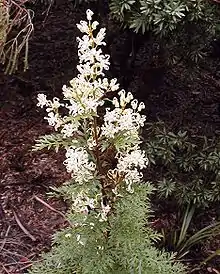Lomatia
Lomatia is a genus of 12 species of evergreen flowering plants in the protea family Proteaceae. Within the family, they have been placed, alone, in their own subtribe, Lomatiinae according to Johnson & Briggs 1975 classification of the family and subsequently in Flora of Australia (1995).
| Lomatia | |
|---|---|
 | |
| L. silaifolia | |
| Scientific classification | |
| Kingdom: | Plantae |
| Clade: | Tracheophytes |
| Clade: | Angiosperms |
| Clade: | Eudicots |
| Order: | Proteales |
| Family: | Proteaceae |
| Subfamily: | Grevilleoideae |
| Tribe: | Embothrieae |
| Subtribe: | Lomatiinae |
| Genus: | Lomatia R.Br. |
| Species | |
|
See text | |
The genus has a Pacific Rim distribution, with members native to eastern Australia and southern South America, forming a part of the Antarctic flora. The species range from prostrate shrubs less than 0.5 m (1 ft 8 in) tall to small trees up to 12 m (39 ft) tall.
Genetic analysis using microsatellite markers showed that species found close together geographically are most closely related to each other. Lomatia dentata, then L. hirsuta and L. ferruginea all diverged successively from the lineage that gave rise to Australian species. The three Tasmanian species (with L. tasmanica sister to the other two species) are sister to the mainland Australian group. L. tasmanica of the three tasmania species, happens to be one of the most endangered species. On mainland Australia, the far northern L. fraxinifolia is sister to the other five species, all of which are found in southeastern Australia. L. fraseri and L. myricoides are sister taxa, with L. ilicifolia sister to them, while L. arborescens and L. silaifolia are each other's closest relatives.[1] Strong genomic filters may facilitate continued gene flow between species without the danger of assimilation.
Species
- Lomatia arborescens - eastern Australia
- Lomatia dentata - Chile, Argentina
- Lomatia ferruginea - Chile, Argentina
- Lomatia fraseri - eastern Australia
- Lomatia fraxinifolia - Queensland
- Lomatia hirsuta - Chile, Peru, Argentina
- Lomatia ilicifolia - eastern Australia
- Lomatia myricoides - southeastern Australia
- †Lomatia occidentalis - (Eocene fossil records) Patagonia [2]
- †Lomatia patagonica - (Late Oligocene-Early Miocene (Ñirihuau Formation) fossil records) Patagonia[2]
- †Lomatia preferruginea - (Middle Eocene fossil records (Ventana Formation) Patagonia[2]
- Lomatia polymorpha (mountain guitarplant)[3] - Tasmania
- Lomatia silaifolia - eastern Australia
- Lomatia tasmanica (King's lomatia) - Tasmania
- Lomatia tinctoria (guitarplant)[3] - Tasmania
References
- Milner, Melita L.; McIntosh, Emma J.; Crisp, Michael D.; Weston, Peter H.; Rossetto, Maurizio (2013). "Microsatellite variation for phylogenetic, phylogeographic and population-genetic studies in Lomatia (Proteaceae)". Australian Systematic Botany. 26 (3): 186–95. doi:10.1071/SB13002.
- Gonzalez, Cynthia C.; Gandolfo Maria Alejandra; Zamaloa, Maria C.; Cúneo, Nestor R.; Wilf, Peter; Johnson, Kirk (2007). "Revision of the Proteaceae Macrofossil Record from Patagonia, Argentina" (PDF). The Botanical Review. 73 (3): 235–66. doi:10.1663/0006-8101(2007)73[235:rotpmr]2.0.co;2.
- H. Wapstra, A. Wapstra, M. Wapstra, L. Gilfedder,The Little Book of Common Names for Tasmanian Plants, DPIPWE
- Wilson, AJG; Hewson, HJ; Mowatt, J (1995). "Lomatia". In McCarthy, Patrick (ed.). Flora of Australia: Volume 16: Eleagnaceae, Proteaceae 1. CSIRO Publishing / Australian Biological Resources Study. pp. 374–382. ISBN 978-0-643-05693-0.
- Hoot, SB & Douglas, AW (1998). "Phylogeny of the Proteaceae based on atpB and atpB-rbcL spacer region sequences". Australian Systematic Botany. 11 (4): 301–320. doi:10.1071/SB98027.
- Johnson, LAS & Briggs, BG (1975). "On the Proteaceae: the evolution and classification of a southern family". Botanical Journal of the Linnean Society. 70 (2): 83–182. doi:10.1111/j.1095-8339.1975.tb01644.x.
External links
- Pictures of Lomatia dentata, Lomatia ferruginea and Lomatia hirsuta from Chilebosque.
- pantherfile.uwm.edu/hoot/www/Prot.html - Hoot/Proteaceae